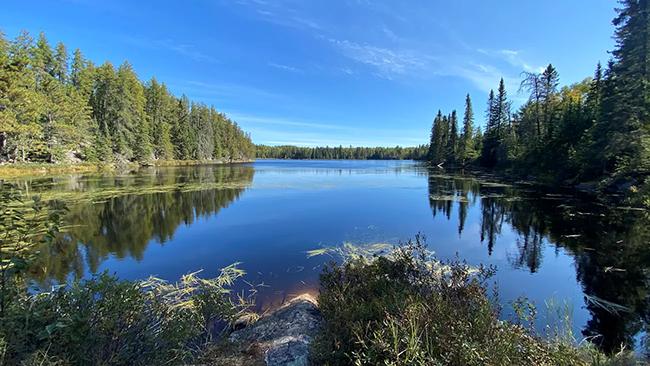Voyageurs National Park in Minnesota experiences four distinct seasons. Summer is, of course, the busiest season in the park because of the mild weather and warm temperatures. Fall is popular with “leaf peepers” wishing to view the brilliant golds, oranges, red, and yellows of the changing leaves on the deciduous trees while experiencing cooler temperatures. Spring brings out the fresh greens and wildflowers, and winter offers snow activities as well as the possible opportunity for driving on an ice road.
Spring

Close-up of a bright columbine, Voyageurs National Park / NPS-B. Tallman
March through May, there may still be snow on the ground in spots, sticking tenaciously through May, but springtime temperatures and colors start to reign during these same three months. Bare tree branches sprout buds while wildflowers such as violets, marsh marigolds, and red columbines add their bright hues to other blooms. There are 400 wildflower species within the park, many of which may not start blooming until June and others lasting from May all the way to August. Temperatures range from a low of 12 degrees Fahrenheit (-11 degrees Celsius) in March to a high of 67 degrees Fahrenheit (19 degrees Celsius) in May, which is also the rainiest of the three spring months, averaging 2.6 inches (6.5 centimeters).
Summer

Summer weather is great for backcountry camping at Voyageurs National Park / NPS-C. Braton
June through August, summer temperatures at Voyager may reach as high as 90 degrees Fahrenheit (32 degrees Celsius) but generally average around the mid-70s Fahrenheit (~24 degrees Celsius) with lows in the low-to-mid 50s Fahrenheit (~13 degrees Celsius). Precipitation is a little under 4 inches (10.2 centimeters) with the most rain occurring in June. Bring plenty of drinking water along with sunblock, a hat, and sunglasses. Also, insect repellent is advised since biting flies, mosquitos, and ticks are around. You might want to wear long pants sprayed with a tick repellent such as permethrin, available under the brand name Sawyer and sold at most sporting goods stores including REI, Cabela’s, Walmart, and Amazon.
Autumn

Autumn brings out the leaf colors, which bring out the "leaf peepers," at Voyageurs National Park / NPS - Lindgren
Cooler temperatures prevail September through November, with fewer pesky insects. While fall colors begin to show up during mid-September, this can vary from year to year. Check the MN Department of Natural Resources Fall Color Finder and don’t forget to bring along your camera to capture the colors. Temperatures average between a high of 65 degrees Fahrenheit (18 degrees Celsius) in September to a low of 16 degrees Fahrenheit (-9 degrees Celsius) in November. September produces the highest precipitation at around 3 inches (7.6 centimeters).
Operational changes occur as the park gears itself toward the approaching winter months. It’s a good idea to check the park’s operating hours page before arriving for a fall visit as the Kabetogama and Ash River Visitor Centers close near the end of September and the Rainy Lake Visitor Center changes hours. National Park Service tour boats conclude tours for the season in the fall. Local commercial services might begin to limit their operations towards the end of September as well, so it is recommended that you call ahead to book any desired services. Park buoys are typically removed in early October, which can make lake navigation difficult.
Winter

During the winter, if it's cold enough and the ice is thick enough, you can drive on an ice road at Voyageurs National Park / NPS
December through February bring sub-freezing temperatures and winter snow and ice. Solitude reigns and crowds thin, although there are plenty of winter-based outdoor activities such as snowshoeing, cross-country skiing, and ice fishing. “Ice in” occurs when the entire lake is frozen over for the first time and the ice cover remains through winter. This term does not indicate ice thickness.
Fun Fact: Voyageurs National Park has an average of 109.4 days per year with a high temperature below 32 °F (0 °C).
Voyageurs National Park ice roads generally open in mid-January and remain accessible through mid-March. The exact timing depends on ice thickness, which must be at least 12 inches (30.5 centimeter) before the roads are opened to traffic. According to the park's winter trails report, the ice roads are usually open on both Rainy Lake and Kabetogama Lake.
If you are interested in knowing more behind-the-scenes information about this national park’s ice roads, check out this article published by Voyageurs Conservancy.





